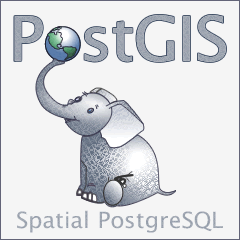DEV (Wed 19 Nov 2025 04:42:17 PM UTC rev. c1613cc )
Il gruppo di sviluppo di PostGIS
Abstract
PostGIS è un'estensione del database object-relational PostgreSQL che consente l'archiviazione di oggetti GIS (Geographic Information Systems). PostGIS comprende il supporto per gli indici spaziali R-Tree basati su GiST, e funzioni per l'analisi e l'elaborazione di oggetti GIS.


Questo è il manuale per la versione 3.4.5dev
 This work is licensed under a Creative Commons Attribution-Share Alike 3.0 License. Feel free to use this material any way you like, but we ask that you attribute credit to the PostGIS Project and wherever possible, a link back to https://postgis.net.
This work is licensed under a Creative Commons Attribution-Share Alike 3.0 License. Feel free to use this material any way you like, but we ask that you attribute credit to the PostGIS Project and wherever possible, a link back to https://postgis.net.
Table of Contents
- 1. Introduzione
- 2. Installazione PostGIS
- 3. Amministrazione di PostGIS
- 4. Data Management
- 5. Spatial Queries
- 6. Consigli per migliori prestazioni
- 7. Guida a PostGIS
- 7.1. PostgreSQL PostGIS tipi Geometry/Geography/Box
- 7.2. Funzioni per la gestione del database
- 7.3. Costruttori geometrici.
- 7.4. Geometry Accessors
- 7.5. Geometry Editors
- 7.6. Geometry Validation
- 7.7. Spatial Reference System Functions
- 7.8. Geometry Input
- 7.9. Geometry Output
- 7.10. Operatori
- 7.11. Spatial Relationships
- 7.12. Measurement Functions
- 7.13. Overlay Functions
- 7.14. Geometry Processing
- 7.15. Coverages
- 7.16. Affine Transformations
- 7.17. Clustering Functions
- 7.18. Bounding Box Functions
- 7.19. Sistemi di riferimento lineare
- 7.20. Trajectory Functions
- 7.21. SFCGAL Functions
- 7.22. Long Transaction Support
- 7.23. Version Functions
- 7.24. Grand Unified Custom Variables (GUCs)
- 7.25. Troubleshooting Functions
- 8. Topologia
- 8.1. Tipi di dato topologici
- 8.2. Domini Topologici
- 8.3. Gestione di topologie e TopoGeometry
- 8.4. Topology Statistics Management
- 8.5. Topology Constructors
- 8.6. Topology Editors
- 8.7. Topology Accessors
- 8.8. Topology Processing
- 8.9. TopoGeometry Constructors
- 8.10. TopoGeometry Editors
- 8.11. TopoGeometry Accessors
- 8.12. TopoGeometry Outputs
- 8.13. Topology Spatial Relationships
- 8.14. Importing and exporting Topologies
- 9. Dati raster: gestione, interrogazione e applicazioni
- 9.1. Caricare e creare raster
- 9.2. Cataloghi raster
- 9.3. Costruire applicazioni personalizzate con PostGIS Raster
- 9.3.1. Esempio di output in PHP, utilizzando ST_AsPNG assieme ad altre funzioni raster
- 9.3.2. Esempio ASP.NET C# di output con ST_AsPNG, assieme ad altre funzioni raster
- 9.3.3. app per Java console per esportare una query raster come file immagine
- 9.3.4. Utilizzare PLPython per esportare immagini tramite SQL
- 9.3.5. Produrre raster con PSQL
- 10. Raster Reference
- 10.1. Raster Support Data types
- 10.2. Raster Management
- 10.3. Raster Constructors
- 10.4. Raster Accessors
- 10.5. Raster Band Accessors
- 10.6. Raster Pixel Accessors and Setters
- 10.7. Raster Editors
- 10.8. Raster Band Editors
- 10.9. Raster Band Statistics and Analytics
- 10.10. Raster Inputs
- 10.11. Raster Outputs
- 10.12. Raster Processing: Map Algebra
- 10.13. Built-in Map Algebra Callback Functions
- 10.14. Raster Processing: DEM (Elevation)
- 10.15. Raster Processing: Raster to Geometry
- 10.16. Raster Operators
- 10.17. Raster and Raster Band Spatial Relationships
- 10.18. Raster Tips
- 11. PostGIS Extras
- 12. Indice delle funzioni speciali di PostGIS
- 12.1. Funzioni Aggregate PostGIS
- 12.2. PostGIS Window Functions
- 12.3. PostGIS SQL-MM Compliant Functions
- 12.4. PostGIS Geography Support Functions
- 12.5. PostGIS Raster Support Functions
- 12.6. PostGIS Geometry / Geography / Raster Dump Functions
- 12.7. PostGIS Box Functions
- 12.8. PostGIS Functions that support 3D
- 12.9. PostGIS Curved Geometry Support Functions
- 12.10. PostGIS Polyhedral Surface Support Functions
- 12.11. PostGIS Function Support Matrix
- 12.12. New, Enhanced or changed PostGIS Functions
- 12.12.1. Funzioni PostGIS aggiunto o migliorate nella versione 3.4
- 12.12.2. Funzioni PostGIS aggiunto o migliorate nella versione 3.3
- 12.12.3. Funzioni PostGIS aggiunto o migliorate nella versione 3.2
- 12.12.4. Funzioni PostGIS aggiunto o migliorate nella versione 3.1
- 12.12.5. Funzioni PostGIS aggiunto o migliorate nella versione 3.0
- 12.12.6. Funzioni PostGIS aggiunto o migliorate nella versione 2.5
- 12.12.7. Funzioni PostGIS aggiunto o migliorate nella versione 2.4
- 12.12.8. Funzioni PostGIS aggiunto o migliorate nella versione 2.3
- 12.12.9. Funzioni PostGIS aggiunto o migliorate nella versione 2.2
- 12.12.10. Funzioni PostGIS aggiunto o migliorate nella versione 2.1
- 12.12.11. Funzioni PostGIS aggiunto o migliorate nella versione 2.0
- 12.12.12. Funzioni PostGIS aggiunto o migliorate nella versione 1.5
- 12.12.13. Funzioni PostGIS aggiunto o migliorate nella versione 1.4
- 12.12.14. Funzioni PostGIS aggiunto o migliorate nella versione 1.3
- 13. Segnalare Problemi
- A. Appendix